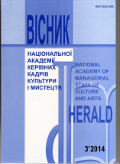ПАРОДІЯ ЯК МЕТОД В УКРАЇНСЬКОМУ ТЕАТРІ
20-х років ХХ століття
Parody as a method is in the Ukrainian theater in 1920-th.
Author(s): Iryna ChuzhynovaSubject(s): Theatre, Dance, Performing Arts, Fine Arts / Performing Arts, Cultural history, Pre-WW I & WW I (1900 -1919), Interwar Period (1920 - 1939)
Published by: Національна академія керівних кадрів культури і мистецтв
Keywords: thetre parody; Ukrainian theatre avant-guard; comedy genre; "korypheys theatre";
Summary/Abstract: A parody as one of the leading methods of creation of the Ukrainian theatrical comic genres in 1920th closely constrained with the formative processes of the Ukrainian avant-guard.However, until now a parody was examined as immanent property of individual stage-director styles. On business, there are all grounds to talk about this method as one of key for becoming of avant-guard art in 1920th. Task of this article is to specify the basic objects of parody, define her basic functions and to review practical realization of this method on the examples of different comic genres.The radical updating of manner and matter of dramatic art became one of key tasks for the Ukrainain theatre after October revolution. The theatrical experiments of the first half of 1920th were aimed at a capture new aesthetics, styles, genres and assuming contiguous airs of arts (foremost to the circus and cinema).Having regard to this stormy process of updating, a theatre in 1920th by means of parody conducts the captious revision of principles of axiology and aesthetic of own existence. It is however important to mark that in the Ukrainian theatre 1920th a parody appealed both to the past and to present tense and was aimed at a few objects.The first object of parody derision in theatricals 1920th was a "korypheys theatre" ("theatre of leading") as powerful artistic phenomenon that was formed in the second half of ХІХ of century and determined dominating style of the Ukrainian theatre in the first decades of ХХ of century yet. This direction for application of parody as good as possible the numerous comedies-remakes of the marked period, in that a theatre works off the mechanism of dialogue with the previous type of a stage culture, is illustrated a method.As the second object of parody, however paradoxically, a vanguard-revolutionary theatre came forward, that in the best standards gravitated towards self-reflectiveness, to the exposure of defects and lacks of agitation-poster presentations, that regularly appeared during all decade. This direction educed itself in different popular comic forms that time – foremost, in the comedies-remakes and theatrical revues.In 1920th outstanding popularity were used by comedies-remakes that one by one appeared on the stages of many theatres. For example, "Poshylys u Durny" (Honeyfuggled themselves) by V. Yaroshenko after M. Kropyvnitskiy (staged by F. Lopatynskiy in the Artistic Association Berezyl, 1924), "Sorochinskiy yarmarok" (Sorochyntsi fair) by M. Tereshenko after M. Gogol and M. Starytskiy (staged by M. Tereshenko in the Theatre-school named after G. Mykhaylychenko, 1924), "Vij" by Ostap Vyshnya after M. Gogol and M. Starytskiy (staged by G. Yura in the Franko Theatre, 1925) and so on.The form of comedy-remake gave to the theatre possibility of direct and active dialogue with the previous epoch of "korypheys theatre". Exactly this immanent property of comedy-remake needed a parody as foremost to the method of creation of intertextual the artistic field that would be general for classic and avant-guard cultures.In comedies-remakes it is possible an urgent task to the parody to name the study of laws of other artistic reality. Exactly through a parody in 1920th the Ukrainian theatre mastered experience of "korypheys theatre" – the close in a historical prospect phenomenon already with the formed style and genre system.Except mastering of experience, a parody had other goal. Can assert that "korypheys theatre" as the phenomenon of the Ukrainian theatrical past that has an outstanding value for becoming of national culture is canonized exactly in the process of his parodying. One of most model for 1920th theatrical-remake was "Vij" by Ostap Vyshnya.A parody was actively used and for criticism of that time theatrical process, exposure of him weak points and, to say, neutralizations of excessive fervor that was the necessary constituent of any ideological engaged presentation. In such performances as "Za dvoma zaytsamy" by V. Vasylko and V. Yaroshenko after M. Starytskiy (staged by V. Vasylko in the Artistic Association Berezyl, 1925; Franko Theatre,1925 and others), "Shpana" (Menagerie) by V. Yaroshenko (staged by Y. Bortnyk in the Artistic Association Berezyl, 1926), revues "Hello, on the air number 477!" (staged by B. Balaban, K. Dyhtyarenko, L. Dubovyk, V. Sklyarenko in the Berezil, 1929), "Four Chemberlens" (staged by B. Balaban and V. Sklyarenko in the Berezil, 1931) a noticeable place in the structure of performance was occupied by scale artistic parodies on a pseudo-revolutionary theatre. As marks Violetta Gudkova, already at the beginning of 1920th a revolutionary splint is formed. To the middle of 1920th he is not only well known, but also easily yields to parodying.We can draw the conclusion, that in presentations of 1920th a parody was one of effective methods, firstly, for the revision of the inherited tradition of "korypheys theatre", secondly, for the self-criticism of theatre that was in the permanent search of own national identity.
Journal: Вісник Національної академії керівних кадрів культури і мистецтв
- Issue Year: 2014
- Issue No: 3
- Page Range: 244-248
- Page Count: 5
- Language: Ukrainian

